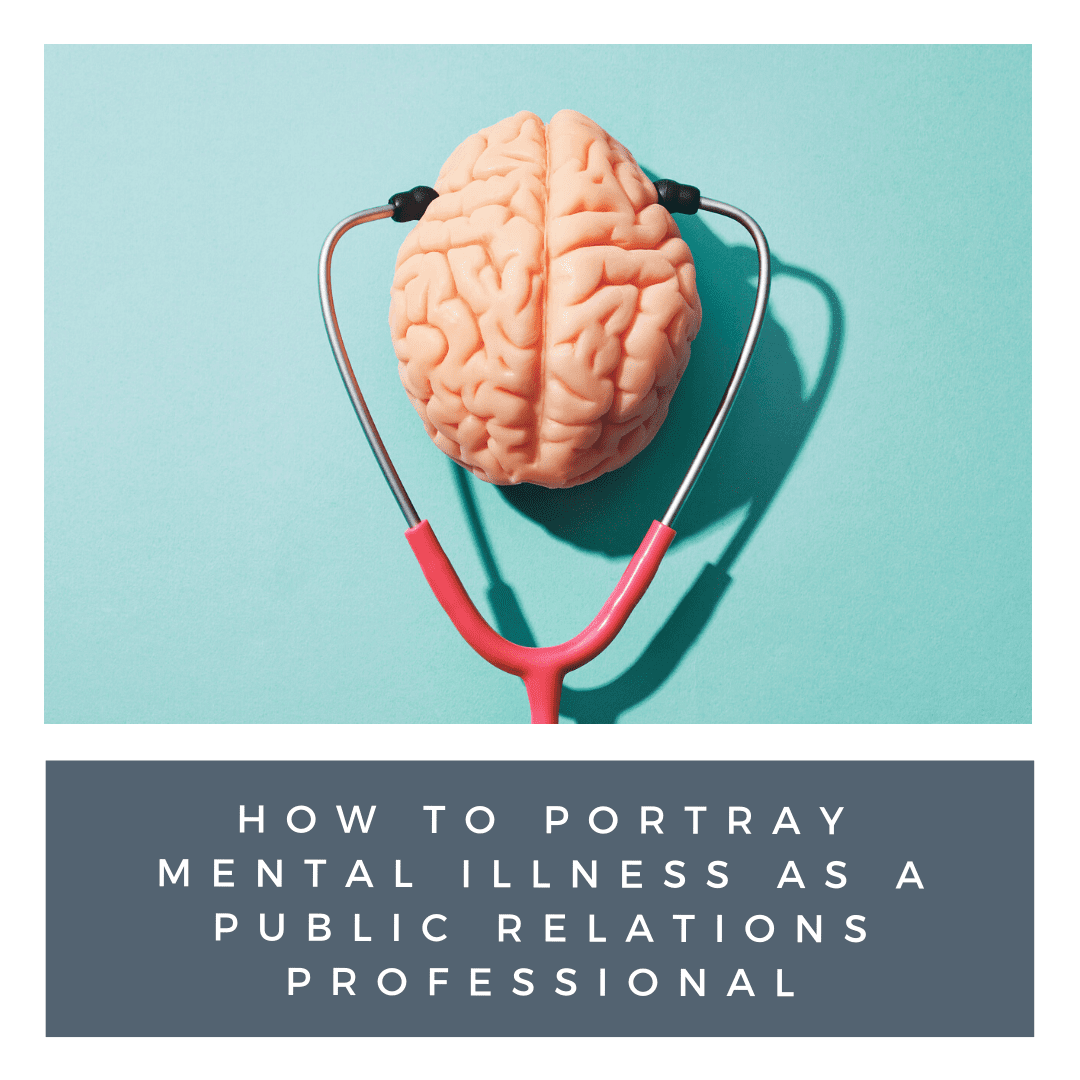
How to Portray Mental Illness as a Public Relations Professional
According to Mental Health First Aid, almost half of adults in the United States will develop a mental illness in their lifetime. It is a condition that affects a person’s thinking, feeling, mood or behavior. Biological, psychological, and environmental factors influence whether or not mental health concerns will develop.
Up until recently, mental health was not a topic of discussion. Even though people struggled with mental health concerns, they did not want to share this with others, as they were afraid that they would be looked down upon by society. But since it has become discussed more frequently in the United States, it is important to have an open conversation about it. Raising awareness around these topics will help eliminate the misconceptions, making people feel more comfortable reaching out for help.
There are a number of organizations that are dedicated to helping people cope with mental health concerns. Some of these organizations include Mental Health America, National Institute of Mental Health, National Alliance on Mental Illness, American Foundation for Suicide Prevention, and Child Mind Institute. In order to best get out a message of prioritizing health, organizations often hire a public relations firm to spread the word about what they have to offer. The public relations firm will write press releases, engage in media relations, and create social media strategies for them. Without public relations, people would not know about the services, resources, and programs that are available to them.
Before creating a holistic communications program for an organization that helps raise awareness and point to available resources, the public relations professional must understand the industry. This will ensure that they are providing the public with accurate, up-to-date information. In order to gain a deeper understanding, they must conduct extensive research about the topic. If they don’t take the time to understand the topics before developing the program, they may include inaccurate information and contribute to the stigma. It is the public relations professional’s responsibility to share the facts so that people are aware of the resources that are out there. By providing truthful information in press releases and social media posts, they will change the it is perceived by society.
Public relations professionals can learn about mental health by reading our blog post about mental health concerns. This will provide a basis for their research and help them understand the fundamentals of mental wellness.
About Mental Health
Even though mental health is a very complex topic, it is important for public relations professionals to understand mental health if they are working on mental health accounts. Mental health and mental disorders are often used interchangeably, but they mean two different things. Mental health refers to “our emotional and psychological state, our social well-being and how we feel about ourselves and interact with others.” Poor mental health can lead to mental illness, but it is not certain.
As mentioned in our blog post Mental Illness and Public Relations, biological, psychological and environmental factors can influence one’s mental health. The exact cause of mental health concerns has not been discovered yet, but researchers believe that a combination of these factors contribute to poor mental health. The biological factors include abnormal functioning of the brain as well as genetics. Those who have a family member with mental illness are susceptible to mental health concerns. If they experience stress, abuse, or a traumatic event, the illness may be triggered, according to WebMD. Other biological factors, such as infections, brain defects or injury, prenatal damage, and substance abuse, also play a role. The psychological factors that contribute to poor mental health are severe psychological trauma, an important early loss, neglect, and inability to relate to other people. The environmental factors refer to a number of stressors, like death or divorce, low self-esteem, and social or cultural expectations, which can impact people who are prone to mental concerns.
There are about 300 mental disorders, in the Diagnostic and Statistical Manual of Mental Disorders(DSM.) Healthcare professionals all over the world use this book to diagnose mental health concerns. Below are the main groups of mental disorders:
- Anxiety disorders (Generalized anxiety disorder, panic disorder, social anxiety disorder, phobias)
- Mood disorders (Depression, bipolar disorder, cyclothymic disorder)
- Psychotic disorders (Schizophrenia)
- Eating disorders (Anorexia nervosa, bulimia nervosa, binge eating disorder)
- Personality disorders (Antisocial personality disorder, obsessive-compulsive personality disorder, paranoid personality disorder)
- Trauma-related disorders (Post-traumatic stress disorder)
- Substance abuse disorders
Even if two people have anxiety disorder, they will not have the same experience. National Alliance on Mental Illness argues that “each person will be affected in a different way because of their own unique nature and personality.” Therefore, they will not have all of the same symptoms. They may have a few symptoms in common, but they will vary in intensity and severity. Some are easier to manage than others. They may still impact daily life, but they will not cause severe distress. Other mental health concerns have such a large impact on people’s lives that hospital care is required.
Struggling with mental health is just as serious as having a physical illness. When someone is suffering from mental health issues, they need a proper diagnosis and treatment. If they do not get the help they need, they will continue to suffer and possibly consider suicide. But people with a mental health concerns are not treated in the same way as those who have a physical illness. For example, people with depression are often asked questions like, “Have you tried not being depressed?” What people don’t realize is that people with depression do not have control over their illness and that they have physical symptoms, such as chronic fatigue, insomnia, difficulty concentrating, persistent feelings of hopelessness and worthlessness. Because people with depression are perceived to be “overly sad,” many of them resist treatment. They believe that their depression is a personal weakness that they can treat themselves, when in reality it is a serious medical illness. By providing information about depression, these organizations are changing people’s views and encouraging people with depression to get help.
Treatment involves medications, psychotherapy, brain-stimulation, and programs. Medications are not a cure, but they do lessen the symptoms. If a person with mental illness takes medication, their other treatments will be more effective. For many people, it is recommended that they don’t just stick to one type of treatment. They should undergo different types of treatment for the best results. The most common types of medications include antidepressants, anti-anxiety medications, mood-stabilizing medications, and antipsychotic medications. Psychotherapy refers to speaking with a mental health professional. This helps people gain a deeper understanding about their condition and how they can cope with it. Just like there are many medications, there are many different types of psychotherapy. If medication and psychotherapy don’t improve one’s symptoms, brain-stimulation treatments, like electroconvulsive therapy or repetitive transcranial magnetic stimulation, are often used. But it is important to know the risks and benefits of a particular brain-stimulation treatment before agreeing to it. If one’s mental health gets worse, it is recommended that they check into a psychiatric hospital for treatment. This includes 24-hour inpatient care, partial or day hospitalization, or residential treatment. Because many people with mental illness have problems with substance use, they may need treatment. If they don’t get help, their mental illness will get worse.
Before public relations professionals start working on mental health accounts, they should research the types of mental illness, their impact, and the resources that are available. This will help them achieve success for their clients. Because there is a lot of information about mental illness on the Internet, public relations professionals ensure that the websites they use are credible. Find out how mental illness is portrayed in the media [MSB3] by reading our next blog post.
How Mental Illness is Portrayed in the Media
Many people learn about mental illness through the media. This is an issue, as the media often portrays mental illness inaccurately. Stephen Hinshaw, a professor of psychology at the University of California-Berkeley, claims, “The worst stereotypes come out in such depictions: mentally ill individuals as incompetent, dangerous, slovenly, undeserving. The portrayals serve to distance ‘them’ from the rest of ‘us.’”
To address this issue, the Associated Press began providing information about mental illness in its Style Book so journalists could discuss mental illness in a fair and accurate way. Despite this, the way mental illness is portrayed in the media is more harmful than ever, according to Dr. Otto Wahl, director of the graduate institute of professional psychology at Connecticut’s University of Hartford.
Therefore, it is important for public relations professionals to be aware of this issue, as they have the power to change the way journalists portray mental illness. They can include factual information about mental illness in their press releases and social media posts to influence the way journalists write about mental illness. Below are some of the ways in which people with mental illness are being portrayed by the media.
Multiple news outlets have written sensational stories about people with mental illness engaging in violent acts. For example, there was an article in which a mental health patient was depicted as threatening, aggressive, and illogical. This slanted language does not provide an accurate representation of people with mental illness, as it has been reported that people with mental illness are actually less likely to engage in violence than those without mental illness. Fictional media also portrays characters with mental illness as violent, further contributing to the mental health stigma.
Fictional media also suggests that people with mental illness appear a certain way. For instance, television characters with mental illness often have messy hair and wrinkled clothing. This leads people to believe that people with mental illness are unable to take care of themselves. While there are quite a few homeless people that are mentally ill, “there are also a huge number of people with mental illnesses who are getting up – showering every day, going to work, etc.,” Wahl claims.
In addition to making people with mental illness look unkept, fictional media suggests that people with mental illness are silly and immature. Their condition is equated to a quirk when in reality it is a serious illness. This does not “convey the way most people with serious mental illnesses are in pain,” Wahl says.
The way the media portrays people with mental illness is very harmful, as it makes people with mental illness feel like outcasts. It also impacts people’s perception of mental illness. For this reason, it is important for public relations professionals to be aware of these portrayals so that they don’t engage in similar practices.
Writing About Mental Health Concerns
Not only is it important to understand mental illness and how it is portrayed by the media, but it also important to understand how to write about mental illness. Public relations professionals should not use derogatory language, such as nuts, deranged, psycho, or crazy, when talking about people with mental illness, as it contributes to the stigma. In addition, it does not make people with mental illness feel good about themselves. This terminology can negatively affect people with mental illness and worsen their symptoms. For this reason, public relations professionals should pay attention to the words they use to portray these topics.
In addition to not using derogatory language, public relations professionals should use person-first language. This means writing “a person with schizophrenia” instead of a “schizophrenic person.” By doing this, they are not defining people by their mental illness.
Public relations professionals should not write that people are “suffering from” or “battling”, as the former suggests they should be pitied and the latter suggests they are not doing everything in their power to overcome the illness. They should also include specific diagnosis names rather than using generalizations.
By choosing their words carefully, public relations professionals have the ability to change the way mental health is perceived by society and eliminate stereotypes. This will motivate people to get the help they need.
- Media Management Tips For C-Suite Executives - July 22, 2024
- Mastering Media Relations: Tips To Increase Media Coverage - July 15, 2024
- PR Crisis Management Strategies for College Administrators - July 9, 2024








